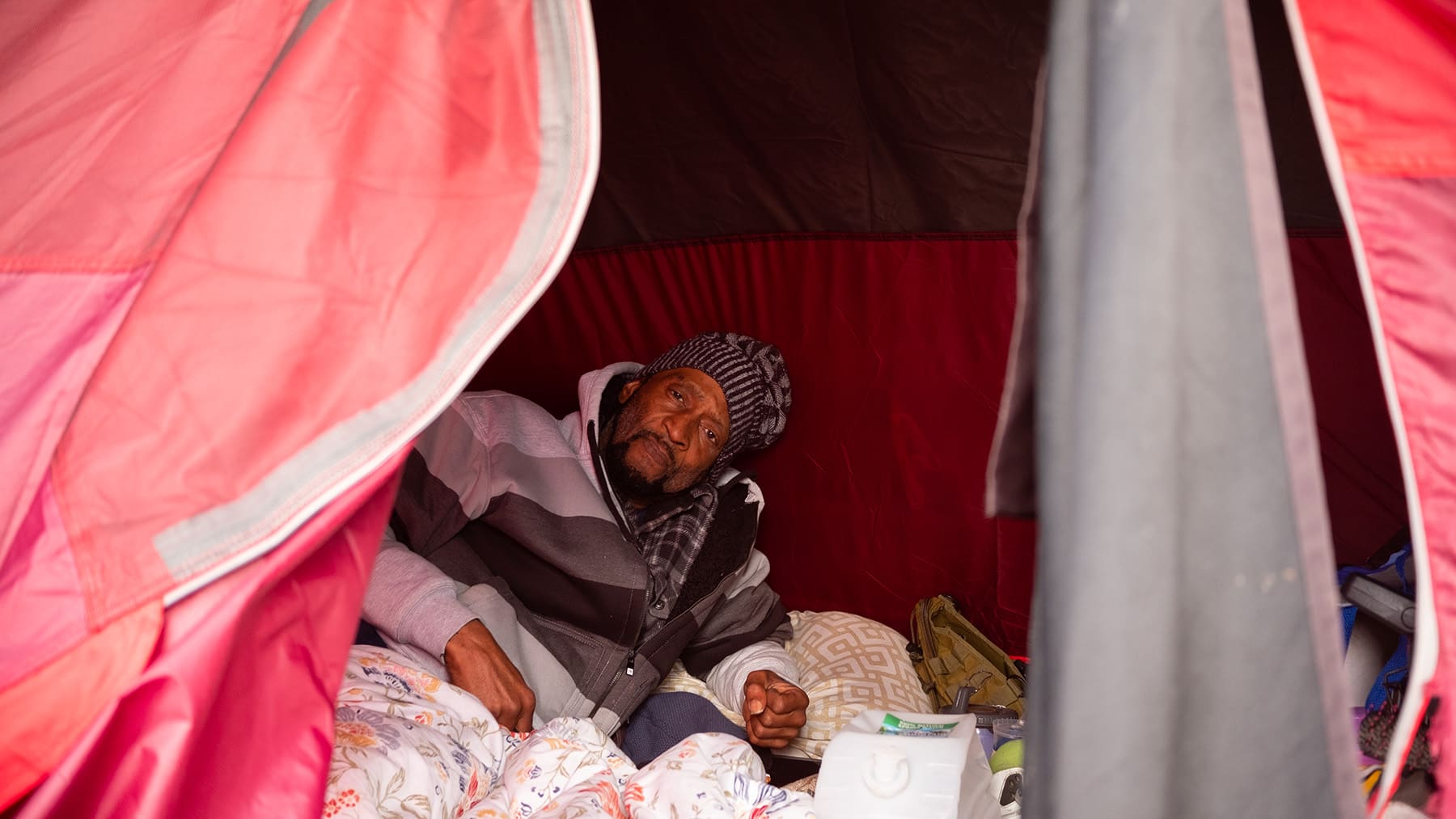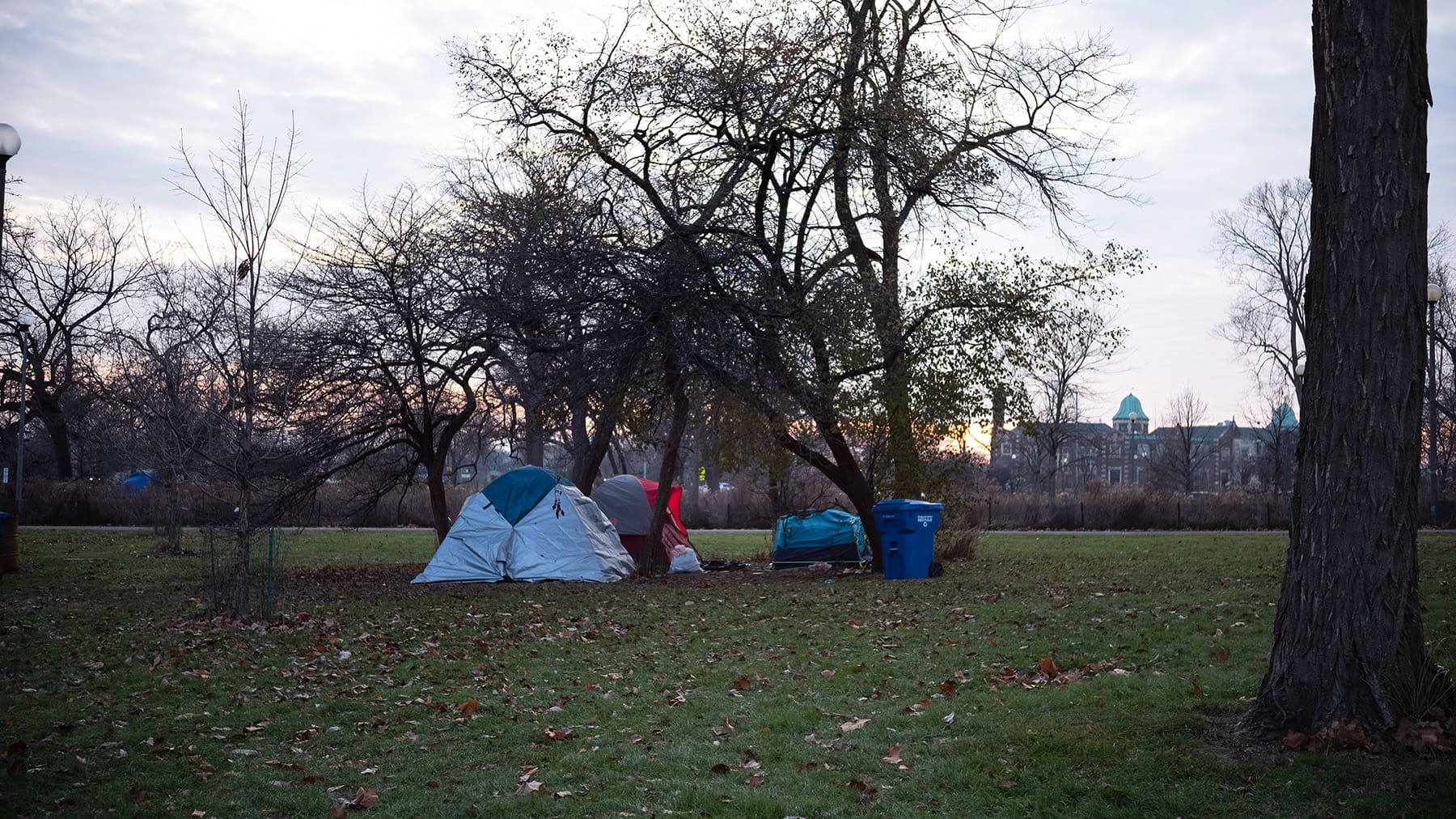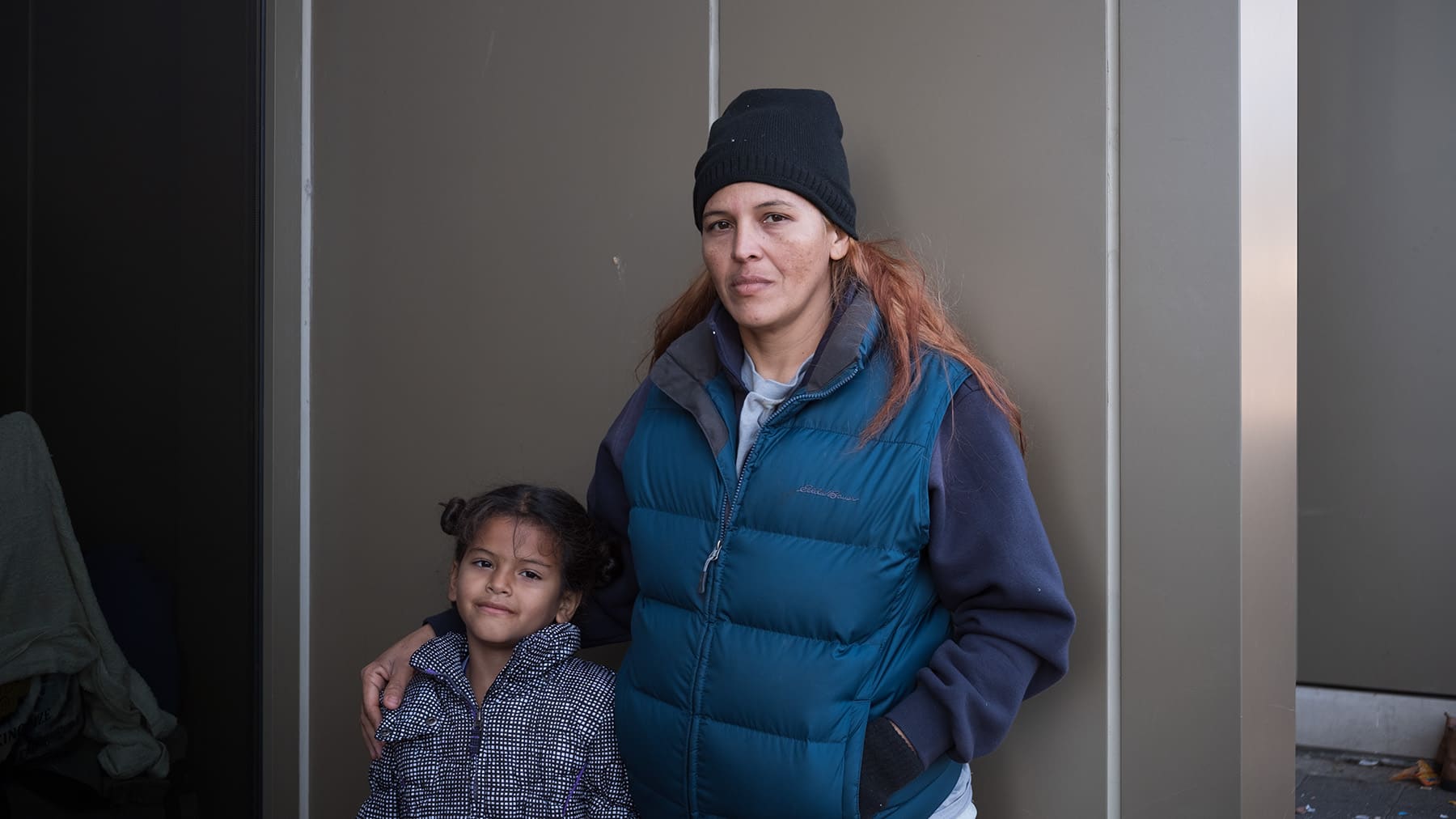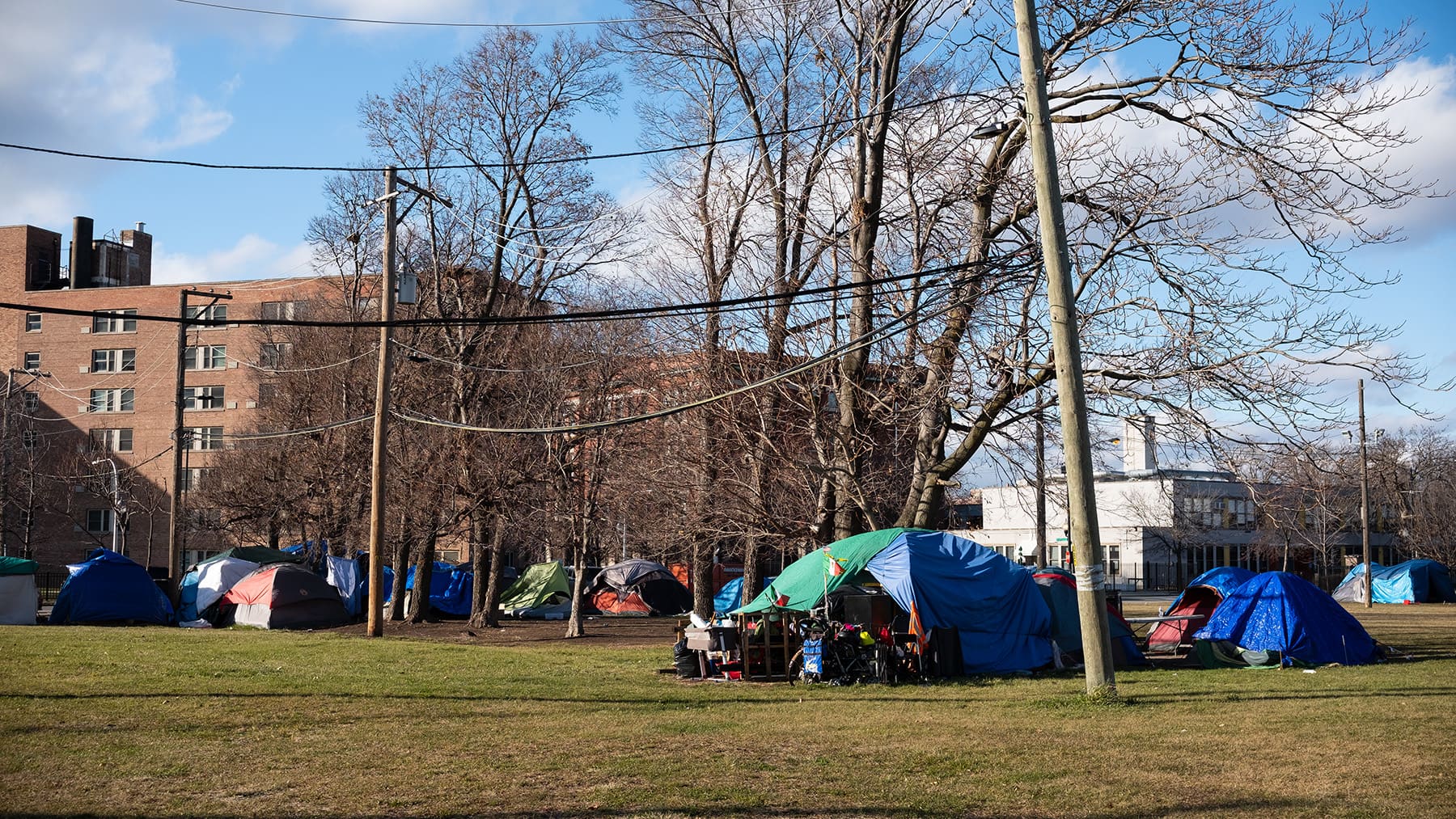Laval’s Tent
By now, the cold of Chicago’s winter had set in. The frigid air was invading Laval’s tent through a recent tear. His thin fishing tent struggled against the December wind and what remained of last night’s bitter rain. Some additional tarps were helping to keep the enclosure insulated, and a friend living in an adjacent tent was helping to mend the rift in the nylon. But as the temperature crept closer to freezing, this small rip would mean more than just a long night. Laval spoke calmly about the situation, but his voice betrayed his unease.
Laval and Roxanne, his wife, have been living by a Humboldt Park park district bathroom for a few months. Residing in the increasingly frigid air of the park’s grassland, they try not to focus on their lack of housing. They are realists. Both know how hard it is to obtain housing right now. So instead of wishing for a front door or a shingled roof, they wish for something more realistic: a better tent.

Laval in his summer fishing tent. Photo by Jeb Backe.
It will be at least another few months until they obtain housing. That’s if their housing assistance program comes through. They are currently connected to the Heartland Alliance through the Homeless Veteran care program at Jesse Brown Hospital. And Laval meets with his assigned caseworker at the hospital regularly.
In the meantime, Laval, Roxanne, and their companions must look out for one another. And they aren’t the only ones. In Humboldt Park alone, this 3-tent group makes up only a fraction of the multitude of single- to multi-tent encampments scattered between trees and bushes. Though unique in their circumstances, Laval and Roxanne’s experiences illuminate the broader plights of dealing with homelessness in Chicago. These and other stories highlight what it looks like to navigate being without housing in Chicago today.

Laval and Roxanne’s encampment in Humboldt Park. Photo by Jeb Backe.
Who “Counts”?
As required by the U.S. Department of Housing and Urban Development (HUD), the Chicago Department of Family and Support Services (DFSS) goes out for a few hours on a night in January and counts the number of people unsheltered and in the shelter systems. This is called the point-in-time (PIT) count. In 2023, DFSS counted 6,139 total residents experiencing homelessness. But how accurate is a one-night canvass?
Carl Wiley, previous employee of HUD’s homeless assistance branch, Continuum of Care (CoC), says, “The PIT count is an extremely flawed measure, but it is a measure. It’s nothing that should be taken as fact. And I think that anyone who’s been in the city for a long time can understand that. The increase of the PIT numbers in 2022 to 2023 is only a few thousand people. But I think what we’re seeing on the street is significantly more than that.”
Carl has worked in the homeless service sector for more than a decade and now works as the chief creative director for the Lyte Collective, a drop-in center for homeless youth. He finds that the Chicago Coalition for the Homeless (CCH) has a more accurate number. The CCH estimates that 68,400 people in Chicago experienced homelessness in 2023. The reason for this discrepancy comes from how each group defines homelessness. The CCH count includes individuals who are temporarily staying with others, or what is called “doubling up” with friends or family. This slight difference in definition affects who is and who is not able to receive government support.
For example, the primary system for connecting folks with housing in Chicago will not help you if you’re doubling up. That system is the Coordinated Entry System, also known as the “One List.” All Chicago Making Homelessness History (All Chicago) runs this system. Nicole Bahena, the vice president of community partnerships at All Chicago, sheds some light on the One List. Prior to the creation of this system, “If you were a person experiencing homelessness, you would have to hustle to try to get on potentially 50 different lists in the hopes that you would get some sort of assistance. About seven years ago, HUD started requiring the creation of a Coordinated Entry System because they, and we, felt that it was better for people experiencing homelessness…to get on one list,” she says.
Housing assistance programs are now united through the Coordinated Entry System. So once connected, you are put on the One List and helped based on the priority of your needs. This process has streamlined what was once a web of disconnected lists operating mostly independently. The only issue remaining in this simplified process is that the One List is under the jurisdiction of HUD’s definition of homelessness. So for example, if you’re homeless but have slept on a couch recently, you don’t have access to this streamlined assistance. “However, going into the new year [2024], processes are changing, so we will be screening people who are doubled-up/couch surfing,” says Nicole Bahena.
For those who are able to get onto the One List, the wait for housing will be long. As of mid-2023, All Chicago estimated the average wait time to be housed was 1,573 days. And while you wait for available housing, “There was actually a stretch of time very recently that there were no shelter beds for you at all,” says Carl Wiley of the Lyte Collective. Laval and Roxanne have been feeling the firsthand effects of this long-term wait. Their housing assistance program through the Heartland Alliance is connected to the Coordinated Entry System. And though it would seem their situation would make them a higher priority, this lack of resources means Laval and Roxanne must remain in a tent while the world around them freezes. When it comes to homeless support systems in Chicago, Carl Wiley says, “The biggest thing that we’re noticing is that a lot of the things that at least sort of barely worked are now not working.” So what’s causing this shift?
Homelessness on the Rise
For starters, homelessness is on the rise in Chicago. The PIT count cites an increase from 3,875 people in 2022 to 6,139 who experienced homelessness in 2023. And PIT numbers account for only a fraction of the number of individuals in Chicago dealing with housing instability.
Falling into homelessness can happen for a myriad of overlapping reasons. And one of them is the lack of affordable housing. Like the rest of the United States, Illinois simply doesn’t have enough homes that are affordable for the lowest-income renters. As of 2021, there was a shortage of 293,354 housing units available for extremely low-income renters in Illinois. To put it into perspective, someone working 40 hours a week at minimum wage is considered an “extremely low-income renter.” And in Chicago specifically, we’ve reached a 10-year high in the gap between the supply of and demand for affordable rental housing. With nearly 17% of Chicago’s population in poverty, that’s at least 450,391 people experiencing potential housing instability.
Laval has seen firsthand how the tipping point into homelessness can happen to anyone at any moment. Laval and Roxanne had been living in an apartment in the Humboldt Park neighborhood on a housing voucher for some time. But things went from bad to worse when Laval caught COVID.
COVID has had a major impact on the lives of many Chicagoans. And at the height of the pandemic, the homeless support response was dramatic: eviction moratoriums, emergency rental assistance, stimulus checks, the American Rescue Plan Act, and more. This expansion of government funding to prevent homelessness provided a safety net that had not previously existed. These boosts in Chicago’s homeless services addressed health care needs for the unhoused and sped up the amount of time to rehouse people.
While some pandemic-era programs such as Accelerated Moving Events remain, many of these homeless prevention procedures are now being scaled back. As a result, many Chicagoans are being left without the support that they have been relying on. All the while, COVID continues to infect and looms as a threat to push vulnerable low-income Chicagoans into the deep end. Though Laval’s experience is specific to his circumstances – major illness and other life-altering events are a major cause for slipping into homelessness – issue after issue compiles, snowballing until eventually the obstacles are insurmountable. And some folks are more often put into these situations than others.
Racial Disparities
Housing segregation and inequitable resources for Black neighborhoods have been well documented throughout the history of the United States. While the discriminatory practice of redlining came to an end in the 1960s-1970s, the fallout of this history continues to be felt.
Today, while 28% of Chicago’s population is Black, 69% of the city’s homeless are Black, according to the 2023 PIT count. Black homeownership significantly lags behind White homeownership, with the highest gap between the two groups in a decade. In 2022, Black applicants experienced a 16.8% denial rate for home purchase applications. Meanwhile, non-Hispanic White applicants had a denial rate of 6.7%.
And Black residents continue to lag behind White residents in generational wealth. Black homeowners are five times more likely to live in a formerly redlined neighborhood and, in Chicago, these neighborhoods continue to have lower home values and fewer resources. A long-term study conducted by HUD has shown that a person is likely to make more money just by living in a wealthier area, as compared to those in Section 8 or public housing.
Rents have also been on the rise, exacerbating the financial burden on renters. Compared to all major cities in the U.S., Chicago has had the most growth in rent prices. A recent study from the National Bureau of Economic Research (NBER) shows that issues of prejudice affect renters, as well. This 2021 research showed that Hispanic/Latino and African American renters received a lower response rate from landlords when compared with White renters. Among the 50 largest cities in the U.S., the NBER found that Chicago landlords discriminate against African American renters the most. And Black and Latino renters on average apply for more apartments than Asian American, Pacific Islander, and White renters. Black, Latino, Asian American, and Pacific Islander renters also pay higher application fees than White renters. And renters of color are charged larger security deposits compared to White renters. These inequitable costs create additional barriers to housing, divided along racial lines.
Sanctuary City
For more than 38 years, Chicago has been a sanctuary city, shielding all immigrants in Chicago, whether they are citizens, permanent residents, or asylum seekers, from federal agents. This has made Chicago a home for more than 26,000 individuals pursuing shelter in the past year. But the political climate surrounding the topic of immigration has become particularly heated, and this has resulted in a struggle between different approaches in how to manage neighbors in need. In August 2022, Republican Texas Governor Greg Abbott began to bus migrants and asylum seekers to cities led by Democrats. Since then, Chicago has received more than 35,050 people from Texas.
There is currently no communication between Texas and Illinois to properly coordinate and secure accommodations. Many see these people now being used as political pawns. Without proper communication and coordination of strategy, the homeless support system in Chicago is being stretched beyond its capabilities. As a result, there are far greater risks to the safety and well-being of immigrants.
The bussing system is also causing a new set of troubles for immigrants like Keilis Urdaneta. Before arriving in Chicago, Keilis had crossed the border from Mexico into Texas around Piedras Negras. At her arrival in the U.S., an organization offered Keilis plane tickets to Chicago, telling her that there would be resources and opportunities for her here. But when she arrived, Keilis found that much of what had been promised to her was not available.
Keilis and her two daughters were able to get connected with a shelter where they can stay. But Keilis’s son is being detained in Texas, and she has been unable to contact him. For now, she is in Chicago with her daughters, one of whom is at risk of cardiac arrest due to a heart murmur, and separated from her son.
Translation: And so I wanted to come because I can get help here, but we only have two months at the shelter and after two months we have to leave, because it’s a paper that we sign, after two months we have to leave.

Keilis and her daughter stand outside the 12th District Chicago Police Department. Photo by Jeb Backe.
Part of the reason Keilis came to the U.S. in the first place was to find better medical care for her daughter. There are trucks that come by the police station to provide some medical assistance; Keilis brings her daughter to those, for now. But this only temporarily mitigates her situation. During the next two months, she will have to navigate finding a way to work, obtaining a visa, and figuring out what’s going on with the detainment of her son. She’ll also be taking care of her daughters and finding a place to live.
Keilis is in a vulnerable position now, but back at home in Venezuela, she was in a different kind of danger.
Translation: I did it like, I’d sell vegetables, potatoes, onions. And because I don’t want to pay for a tax, that is, a fee [to the cartels]. I had to close the shop. In other words, after that, we lived under threat. I decided to come here to give my children opportunities in their studies. That’s why I’m here.
Keilis is clearly motivated to create a better life for her children — both for their health and for their schooling. She spoke of her history in front of the 12th District Chicago Police Department. There, she was in the company of many of her fellow Venezuelan immigrants. Venezuela has suffered a massive economic collapse over the past decade. Economic instability in combination with socio-political turmoil has unraveled into a humanitarian crisis. Twenty percent of the population has fled Venezuela and continues to leave at an average rate of 2,000 people per day.
The influx of immigrants and asylum seekers has created a visible difference in the number of people who are housing insecure and/or homeless in Chicago. In the 2023 PIT count, asylum seekers accounted for 42% of individuals in the Chicago shelter system. It had been a common sight throughout 2023 to see such individuals and families gathered in the lobbies or camped outside police stations, as Chicago police districts had been established as shelters for those seeking asylum. But by the end of December 2023, these people were cleared out. It remains unclear how many of those removed were resettled in safe environments.

Encampment in open lot adjacent to the 12th District Chicago Police Department. Photo by Jeb Backe.
Carl Wiley of the Lyte Collective states, “We’re [Chicago] not really able to effectively help anyone. I don’t think that having people stagnate on the floor of a police station is really a sanctuary...We just sort of opened the doors without having any system in place...I don’t know if Chicago should be proud of the services that we’re providing folks.”
This seems to be a common sentiment among homeless service professionals and those who have experienced homelessness. Chicago had already been struggling to help the local homeless population, and the additional homeless individuals sent to the city have strained a burdened system. Those who suffer the most are the people being shuffled around, forced to sleep outside without coordinated measures to protect their well-being.
Efforts at Work
The chaos of changing deeply ingrained systems and constantly shifting factors can make the problem of homelessness seem unsolvable. But there are always steps forward. This myriad of issues is being met with ever-evolving help.
Drop-in centers, such as the Lyte Collective, are popping up around the city with new forms of aid. And a number of groups are integrating boots-on-the-ground care into their work. Alongside other strategies, The Night Ministry utilizes a specially outfitted bus to bring nurse practitioners, caseworkers, supplies, and food to neighborhoods across Chicago. Laval and Roxanne specifically noted how The Night Ministry provided propane tanks for a period of time, making a tremendous difference in keeping them warm at night. And Accelerated Moving Events places folks in housing with relative immediacy, bypassing the wait on the One List. These efforts need more funding to stay consistent in their work, especially as funding from pandemic-era programs is drying up.

Edward O. Davis and Sylvester Farmer restock to-go meals outside the Night Ministry truck in Garfield Park. Photo by Jeb Backe.
In response to the lack of resources, there are efforts to build new systems of financial backing for homeless support programs. Bring Chicago Home has been campaigning since 2018 to restructure the real estate transfer tax (RETT). The proposal would place a one-time tax on property sales; this tax would be dedicated to financing permanent affordable housing for people experiencing homelessness. In the restructuring of RETT, properties sold for less than $1 million would see a decrease in tax, and properties sold for more than $1 million would have an increase. The intention is to preserve existing housing, create new housing, finance housing vouchers, and expand into other potential housing support models. This campaign has gained more traction recently, and folks such as Otha Gaston from the Lived Experience Commission are pushing for Bring Chicago Home to be voted into policy in 2024. Having previously been homeless, Otha feels impassioned to canvass and get the word out. In Otha’s eyes, “If you’re in a position to help, I believe you should help.”
But poverty is at the heart of the issue. The Center on Budget and Policy Priorities has found that economic security programs reduce overall poverty and racial and ethnic inequities. This could come in the form of expanding tax credits, establishing adequate Supplemental Nutrition Assistance Program (SNAP) benefits, strengthening rental assistance, increasing the number of families who get temporary assistance for needy families (TANF), removing immigration-related restrictions on government benefits (and receiving them without risking immigration status), and addressing discriminatory practices in housing and income support. Had they been better supported in maintaining their housing voucher, Laval and Roxanne perhaps never would have ended up living outside, just a few blocks from their old apartment.
The Poverty & Race Research Action Council (PRRAC) argue that another potential solution to homelessness in the United States could lie in the decommodification of housing. This would mean redefining housing as a public good, like mass transit or libraries. The Housing First model has become the primary philosophy behind most homeless support systems. This model asserts that a person must first have a home and food before they are able to address other issues in their lives. The intention is to bypass a process in which one must earn housing; instead, housing is treated as a human right. Providing housing first has been shown to lead to an increased quality of life and long-lasting housing stability. An expansion at this level would mean that Roxanne is better able to focus on her health as she carries a child or that Keilis could focus on obtaining proper medical treatment for her daughter.
Back at the Tent
As the cold intensified, each gust of wind cut through Laval and Roxanne like a knife. A few weeks after the tear in the canvas of their summer fishing tent, they had a bit of good luck. A friend staying nearby in Humboldt Park had moved and left them his tall, winterized tent. Laval had been out with errands the first day of the move, and all he wanted to do was get warm.
An insulated tent is notably better than a summer fishing tent when temperatures drop below freezing. But Laval and Roxanne need permanent housing. For now, they must continue to wait. From there, one can only hope that they will be able to maintain that housing and that Roxanne’s baby is born healthy and can come home to a place with heat and running water.
Jeb Backe is a freelance journalist in Chicago.

